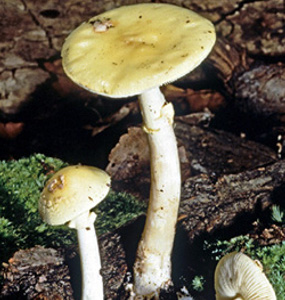Amanita citrina

Image Courtesy of Eleanor Yarrow
| Click to Enlarge |
| Click For Image Gallery |
|
Group of Fungi: Agarics Family: Amanitaceae Latin Name: Amanita citrina (Pers.) Pers. Common Name: Citron Amanita Description: Total height 3–5 in (7.5–12.5 cm); cap 2–4 in (5–10 cm) wide, lemon-yellow to pale yellowish green, upper surface with scattered irregular white patches; gills closely spaced, white; stalk 2 3/4–4 3/4 in (7–12 cm) long, 3/8–5/8 in (1–1.5 cm) in diameter, noticeably expanded at base, white; annulus present near top of stalk, yellowish white; volva present at base of stalk, usually present only as fragments clinging to base, white to dingy buff; spores white in mass. Biological Role: Forms mycorrhizal associations with forest trees. Habitat: On the ground in broadleaf and conifer (especially pine) forests; usually solitary but sometimes occurring in scattered groups. Geographical Distribution: Found throughout North America. Comments: Amanita citrina is poisonous if consumed. There should be relatively little chance of this happening, since this fungus resembles several of the deadly poisonous species of Amanita (for example, Amanita bisporigera) that even the casual mushroom hunter is likely to know enough to avoid. It can be quite common in some oak forests during late summer. |
| Go Back |